

An anemic galaxy is a type of spiral galaxy characterized by a low contrast between its spiral arms and its disk.


An anemic galaxy is a type of spiral galaxy characterized by a low contrast between its spiral arms and its disk.
The term was coined in 1976 by the Canadian astronomer Sidney van den Bergh to classify galaxies that are an intermediate form between the gas-rich, star-forming spiral galaxies and the gas-poor, inactive lenticular galaxies. [1]
Anemic galaxies not only show spiral arms of low contrast but also a low content and density of neutral hydrogen (the raw material needed to form stars), [2] [3] redder colours than a normal spiral, fewer H II regions, and thus a low star formation activity. [3]
At first it was believed their molecular hydrogen content was similar to that of a normal spiral, [4] but subsequent studies have shown that a number of them are deficient in molecular gas. [5]
Anemic galaxies should not be confused with galaxies with red colors due to a low star formation activity but which show a normal content of neutral gas, as is the case of the Andromeda Galaxy. [6] [7]
As most galaxies of this type are present in rich galaxy clusters, it has been proposed that this may be one of the reasons that normal spirals convert into anemic ones. Studies of spiral galaxies in the nearby Virgo cluster have shown not only how, unlike in isolated spiral galaxies, in most cases their neutral gas and star formation are truncated within their optical disks, in some cases quite severely, [8] [9] but also how star formation activity in them is lower than in spirals outside clusters; [9] this means that processes that take place in galaxy clusters, such as interactions with the intracluster medium like ram-pressure stripping and/or interactions with other neighboring galaxies, are responsible for the origin of anemic galaxies, stripping the normal spirals of their gas, increasing in some cases their star formation activity, and thus in the end quenching the latter as their gas is exhausted and not replenished. [10] Spiral galaxies may have become anemic ones by exhausting their supply of gas via star formation activity. [3]
An anemic galaxy's most probable fate is to lose its remaining gas and star formation, becoming similar to a lenticular galaxy: it therefore is likely that most lenticular galaxies in clusters, are former spiral galaxies. [10]
Passive spiral galaxies (also known as passive spirals) are a type of spiral galaxy located in rich galaxy clusters at high redshifts that present spiral structure, but little or no star formation, [11] in some cases hidden by dust and concentrated within their innermost regions. [12] Often, they seem to have few or no massive (>20 solar masses) stars. [12]
According to computer simulations, they are systems on the way to becoming lenticular galaxies as they have lost the hydrogen that is assumed to be present in the haloes of spiral galaxies and that replenishes them with new gas to form stars. [13]
While they share at least some properties with anemic galaxies, [14] their relationship with them is unclear: [13] they may be a more advanced stage in the evolution of a spiral galaxy to become a lenticular than the anemic galaxies, [15] or passive spirals and anemic galaxies may be the same type of object, the difference being that the former are much farther away than the latter. [16]
NGC 4921 in the Coma Cluster and Messier 90 in the Virgo Cluster are examples of this type of galaxy; [1] however, most spiral galaxies of the latter are more or less deficient in gas. [2]

The Virgo Cluster is a large cluster of galaxies whose center is 53.8 ± 0.3 Mly away in the constellation Virgo. Comprising approximately 1,300 member galaxies, the cluster forms the heart of the larger Virgo Supercluster, of which the Local Group is a member. The Local Group actually experiences the mass of the Virgo Supercluster as the Virgocentric flow. It is estimated that the Virgo Cluster's mass is 1.2×1015M☉ out to 8 degrees of the cluster's center or a radius of about 2.2 Mpc.

A lenticular galaxy is a type of galaxy intermediate between an elliptical and a spiral galaxy in galaxy morphological classification schemes. It contains a large-scale disc but does not have large-scale spiral arms. Lenticular galaxies are disc galaxies that have used up or lost most of their interstellar matter and therefore have very little ongoing star formation. They may, however, retain significant dust in their disks. As a result, they consist mainly of aging stars. Despite the morphological differences, lenticular and elliptical galaxies share common properties like spectral features and scaling relations. Both can be considered early-type galaxies that are passively evolving, at least in the local part of the Universe. Connecting the E galaxies with the S0 galaxies are the ES galaxies with intermediate-scale discs.

Messier 32 is a dwarf "early-type" galaxy about 2,650,000 light-years (810,000 pc) from the Solar System, appearing in the constellation Andromeda. M32 is a satellite galaxy of the Andromeda Galaxy (M31) and was discovered by Guillaume Le Gentil in 1749.

A dwarf galaxy is a small galaxy composed of about 1000 up to several billion stars, as compared to the Milky Way's 200–400 billion stars. The Large Magellanic Cloud, which closely orbits the Milky Way and contains over 30 billion stars, is sometimes classified as a dwarf galaxy; others consider it a full-fledged galaxy. Dwarf galaxies' formation and activity are thought to be heavily influenced by interactions with larger galaxies. Astronomers identify numerous types of dwarf galaxies, based on their shape and composition.
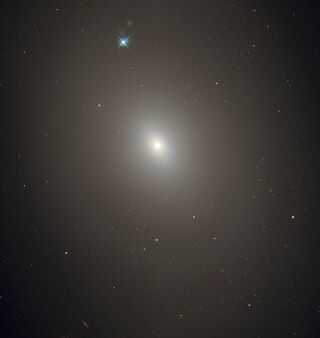
Messier 85 is a lenticular galaxy, or elliptical galaxy for other authors, in the Coma Berenices constellation. It is 60 million light-years away, and it is estimated to be 125,000 light-years across.
Messier 86 is an elliptical or lenticular galaxy in the constellation Virgo. It was discovered by Charles Messier in 1781. M86 lies in the heart of the Virgo Cluster of galaxies and forms a most conspicuous group with another large galaxy known as Messier 84. It displays the highest blue shift of all Messier objects, as it is, net of its other vectors of travel, approaching the Milky Way at 244 km/s. This is due to both galaxies falling roughly towards the center of the Virgo cluster from opposing ends.

Messier 90 is an intermediate spiral galaxy exhibiting a weak inner ring structure about 60 million light-years away in the constellation Virgo. It was discovered by Charles Messier in 1781.
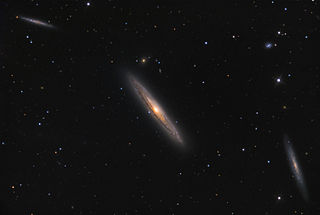
NGC 4216 is a metal-rich intermediate spiral galaxy located not far from the center of the Virgo Cluster of galaxies, roughly 55 million light-years away. It is seen nearly edge-on.
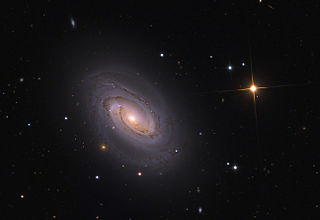
NGC 4450 is a spiral galaxy in the constellation Coma Berenices.

NGC 4323 is a lenticular or dwarf elliptical galaxy located about 52.5 million light-years away in the constellation Coma Berenices. The galaxy was discovered in 1882 by astronomer Wilhelm Tempel and is a member of the Virgo Cluster.

NGC 4651 is a spiral galaxy located in the constellation of Coma Berenices that can be seen with amateur telescopes, at a distance not well determined that ranges from 35 million light years to 72 million light years.
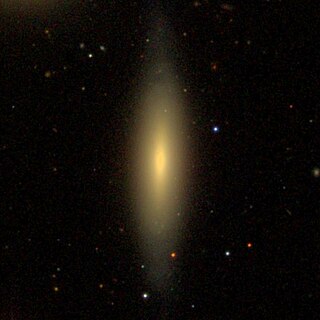
NGC 4550 is a barred lenticular galaxy located in the constellation of Virgo that can be seen with amateur telescopes. It lies at a distance of 50 million light-years from the Milky Way and is a member of the Virgo Cluster.

NGC 4698 is a barred spiral galaxy located around 55 million light years away from Earth in the constellation of Virgo. It belongs to the Virgo Cluster of galaxies and is positioned near the northeastern edge of this assemblage. The morphological classification of NGC 4698 in the De Vaucouleurs system is SA(s)ab, which indicates a purely spiral structure with moderate to tightly wound arms. It is inclined to the line of sight from the Earth by an angle of 53° along a position angle of 170°.
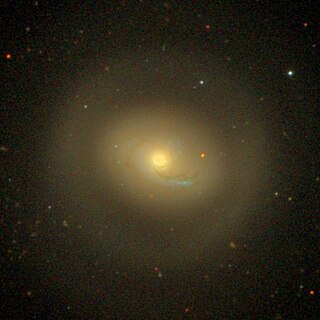
NGC 4457 is an intermediate spiral galaxy located about 55 million light-years away in the constellation of Virgo. It is also classified as a LINER galaxy, a class of active galaxy defined by their spectral line emissions. NGC 4457 Is inclined by about 33°. It was discovered by astronomer William Herschel on February 23, 1784. Despite being listed in the Virgo Cluster Catalog as VCC 1145, NGC 4457 is a member of the Virgo II Groups which form an extension of the Virgo cluster.

NGC 4294 is a barred spiral galaxy with flocculent spiral arms located about 55 million light-years away in the constellation Virgo. The galaxy was discovered by astronomer William Herschel on March 15, 1784 and is a member of the Virgo Cluster.

NGC 4298 is a flocculent spiral galaxy located about 53 million light-years away in the constellation Coma Berenices. The galaxy was discovered by astronomer William Herschel on April 8, 1784 and is a member of the Virgo Cluster.

NGC 4299 is a featureless spiral galaxy located about 55 million light-years away in the constellation Virgo. It was discovered by astronomer William Herschel on March 15, 1784 and is a member of the Virgo Cluster.

NGC 4302 is an edge-on spiral galaxy located about 55 million light-years away in the constellation Coma Berenices. It was discovered by astronomer William Herschel on April 8, 1784 and is a member of the Virgo Cluster.

NGC 4318 is a small lenticular galaxy located about 72 million light-years away in the constellation Virgo. It was discovered by astronomer John Herschel on January 18, 1828. NGC 4318 is a member of the Virgo W′ group, a group of galaxies in the background of the Virgo Cluster that is centered on the giant elliptical galaxy NGC 4365.

NGC 4324 is a lenticular galaxy located about 85 million light-years away in the constellation Virgo. It was discovered by astronomer Heinrich d'Arrest on March 4, 1862. NGC 4324 has a stellar mass of 5.62 × 1010M☉, and a baryonic mass of 5.88 × 1010M☉. The galaxy's total mass is around 5.25 × 1011M☉. NGC 4324 is notable for having a ring of star formation surrounding its nucleus. It was considered a member of the Virgo II Groups until 1999, when its distance was recalculated and it was placed in the Virgo W Group.